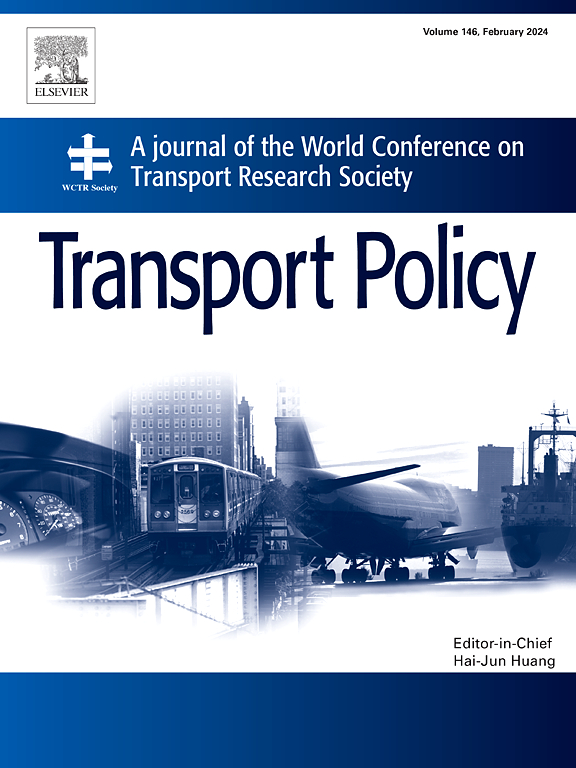碳排放交易体系的建立如何影响为硫排放控制区设计的船舶减排策略
IF 6.3
2区 工程技术
Q1 ECONOMICS
引用次数: 0
摘要
作为国际海运贸易的支柱,航运业的污染和排放问题受到各国政府和国际组织的高度关注。国际海事组织划定了五个排放控制区(ECAs),限制船舶的硫氧化物排放。同时,欧盟从 2024 年起将航运业纳入欧盟排放交易体系,以控制其碳排放量。为遵守 ECA 法规,航运业通常会采用更换燃料、安装洗涤器或绕道等策略,但这些策略可能会增加碳排放量,并可能产生额外的碳交易成本。在这种情况下,航运公司应研究海洋排放交易系统(METS)对 ECA 法规下使用的减排策略的影响。因此,本文重点研究了这一问题,并将其表述为一个混合整数非线性编程模型。本文进行了多次数值实验,以证明所提模型的适用性。结果表明,在 ECA 法规下,船舶绕航行为不可避免,会产生更多的碳排放。在不考虑 METS 法规的情况下,最佳减排策略是安装洗涤器。相反,当考虑 METS 法规时,根据不同的航行路线,最优选择可能是安装洗涤器或燃料转换,这说明了 METS 对船舶减排策略的影响。此外,安装洗涤器策略的船队部署和航行速度受到 METS 法规的影响,而燃料转换和使用液化天然气动力船的策略几乎不受影响。这表明安装洗涤器更容易受到排放控制政策的影响。本文章由计算机程序翻译,如有差异,请以英文原文为准。
How the establishment of carbon emission trading system affects ship emission reduction strategies designed for sulfur emission control area
As the backbone of the international seaborne trade, the pollution and emission from shipping are highly concerned by governments and international organizations as well. The International Maritime Organization has designated five emission control areas (ECAs) to limit sulfur oxides emissions of ships. Meanwhile, the European Union has included the shipping industry in the EU Emission Trading System since 2024 to control their carbon emissions. The strategies like switching fuel, installing scrubber or detour, are commonly used to comply with the ECA regulation, but they may increase carbon emissions and possibly incur extra carbon trading cost. In this case, the shipping company should investigate the influence of marine emission trading system (METS) on emission reduction strategies used under ECA regulation. Therefore, this paper focuses on this problem and formulates it as a mixed-integer nonlinear programming model. Several numerical experiments are conducted to show the applicability of the proposed model. The results show that ship's detour behavior is inevitable under the ECA regulation, which incurs more carbon emissions. When METS regulation is not considered, the optimal emission reduction strategy is installing scrubber. In contrast, when METS regulation is considered, the optimal choice may be installing scrubber or fuel switching depending on different sailing route, which indicates the effect of METS on ship emission reduction strategy. Moreover, the fleet deployment and sailing speed of scrubber installation strategy are affected by METS regulation, while the strategies of fuel switching and using LNG-powered ship are almost unaffected. This indicates that installing scrubber is more easily affected by emission control policies.
求助全文
通过发布文献求助,成功后即可免费获取论文全文。
去求助
来源期刊

Transport Policy
Multiple-
CiteScore
12.10
自引率
10.30%
发文量
282
期刊介绍:
Transport Policy is an international journal aimed at bridging the gap between theory and practice in transport. Its subject areas reflect the concerns of policymakers in government, industry, voluntary organisations and the public at large, providing independent, original and rigorous analysis to understand how policy decisions have been taken, monitor their effects, and suggest how they may be improved. The journal treats the transport sector comprehensively, and in the context of other sectors including energy, housing, industry and planning. All modes are covered: land, sea and air; road and rail; public and private; motorised and non-motorised; passenger and freight.
 求助内容:
求助内容: 应助结果提醒方式:
应助结果提醒方式:


